2016 NISSAN PATHFINDER Chains
[x] Cancel search: ChainsPage 433 of 540
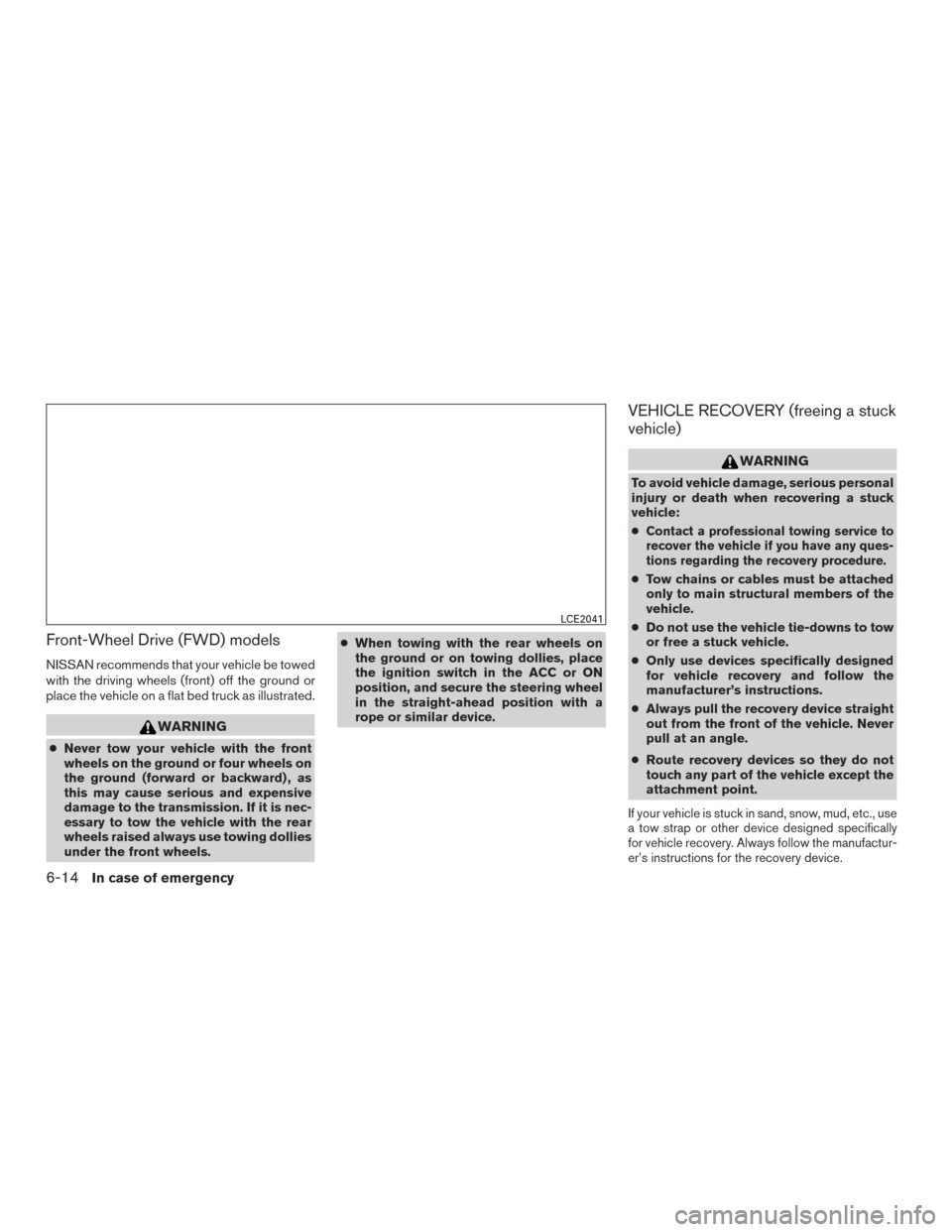
Front-Wheel Drive (FWD) models
NISSAN recommends that your vehicle be towed
with the driving wheels (front) off the ground or
place the vehicle on a flat bed truck as illustrated.
WARNING
●Never tow your vehicle with the front
wheels on the ground or four wheels on
the ground (forward or backward) , as
this may cause serious and expensive
damage to the transmission. If it is nec-
essary to tow the vehicle with the rear
wheels raised always use towing dollies
under the front wheels. ●
When towing with the rear wheels on
the ground or on towing dollies, place
the ignition switch in the ACC or ON
position, and secure the steering wheel
in the straight-ahead position with a
rope or similar device.
VEHICLE RECOVERY (freeing a stuck
vehicle)
WARNING
To avoid vehicle damage, serious personal
injury or death when recovering a stuck
vehicle:
●
Contact a professional towing service to
recover the vehicle if you have any ques-
tions regarding the recovery procedure.
● Tow chains or cables must be attached
only to main structural members of the
vehicle.
● Do not use the vehicle tie-downs to tow
or free a stuck vehicle.
● Only use devices specifically designed
for vehicle recovery and follow the
manufacturer’s instructions.
● Always pull the recovery device straight
out from the front of the vehicle. Never
pull at an angle.
● Route recovery devices so they do not
touch any part of the vehicle except the
attachment point.
If your vehicle is stuck in sand, snow, mud, etc., use
a tow strap or other device designed specifically
for vehicle recovery. Always follow the manufactur-
er’s instructions for the recovery device.
LCE2041
6-14In case of emergency
Page 444 of 540
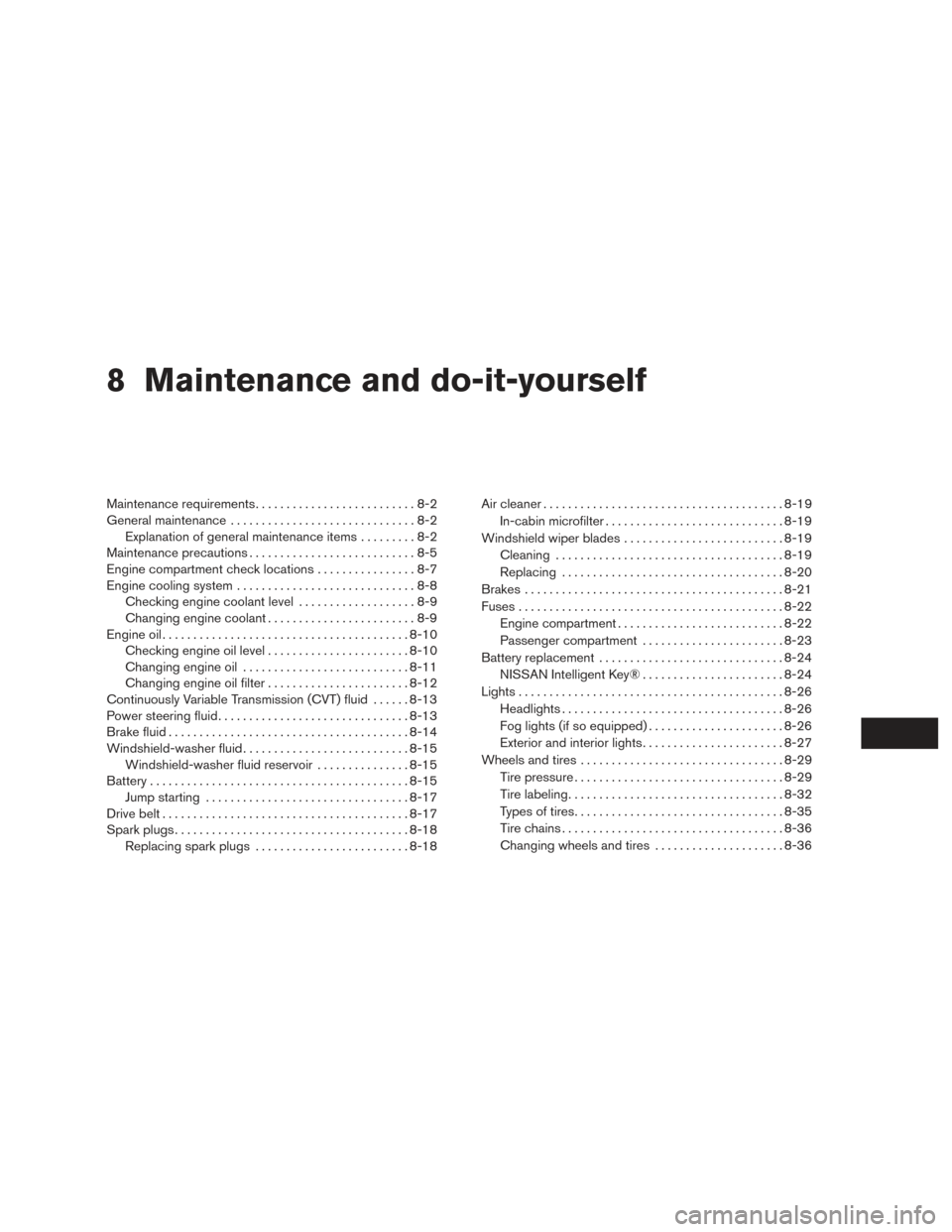
8 Maintenance and do-it-yourself
Maintenance requirements..........................8-2
General maintenance ..............................8-2
Explanation of general maintenance items .........8-2
Maintenance precautions ...........................8-5
Engine compartment check locations ................8-7
Engine cooling system .............................8-8
Checking engine coolant level ...................8-9
Changing engine coolant ........................8-9
Engine oil ........................................ 8-10
Checking engine oil level .......................8-10
Changing engine oil ........................... 8-11
Changing engine oil filter .......................8-12
Continuously Variable Transmission (CVT) fluid ......8-13
Power steering fluid ............................... 8-13
Brake fluid ....................................... 8-14
Windshield-washer fluid ........................... 8-15
Windshield-washer fluid reservoir ...............8-15
Battery .......................................... 8-15
Jump starting ................................. 8-17
Drive belt ........................................ 8-17
Spark plugs ...................................... 8-18
Replacing spark plugs ......................... 8-18Air cleaner
....................................... 8-19
In-cabin microfilter ............................. 8-19
Windshield wiper blades .......................... 8-19
Cleaning ..................................... 8-19
Replacing .................................... 8-20
Brakes .......................................... 8-21
Fuses ........................................... 8-22
Engine compartment ........................... 8-22
Passenger compartment .......................8-23
Battery replacement .............................. 8-24
NISSAN Intelligent Key® .......................8-24
Lights ........................................... 8-26
Headlights .................................... 8-26
Fog lights (if so equipped) ......................8-26
Exterior and interior lights .......................8-27
Wheels
and tires ................................. 8-29
Tire pressure .................................. 8-29
Tire labeling ................................... 8-32
Types of tires .................................. 8-35
Tire chains .................................... 8-36
Changing wheels and tires .....................8-36
Page 479 of 540
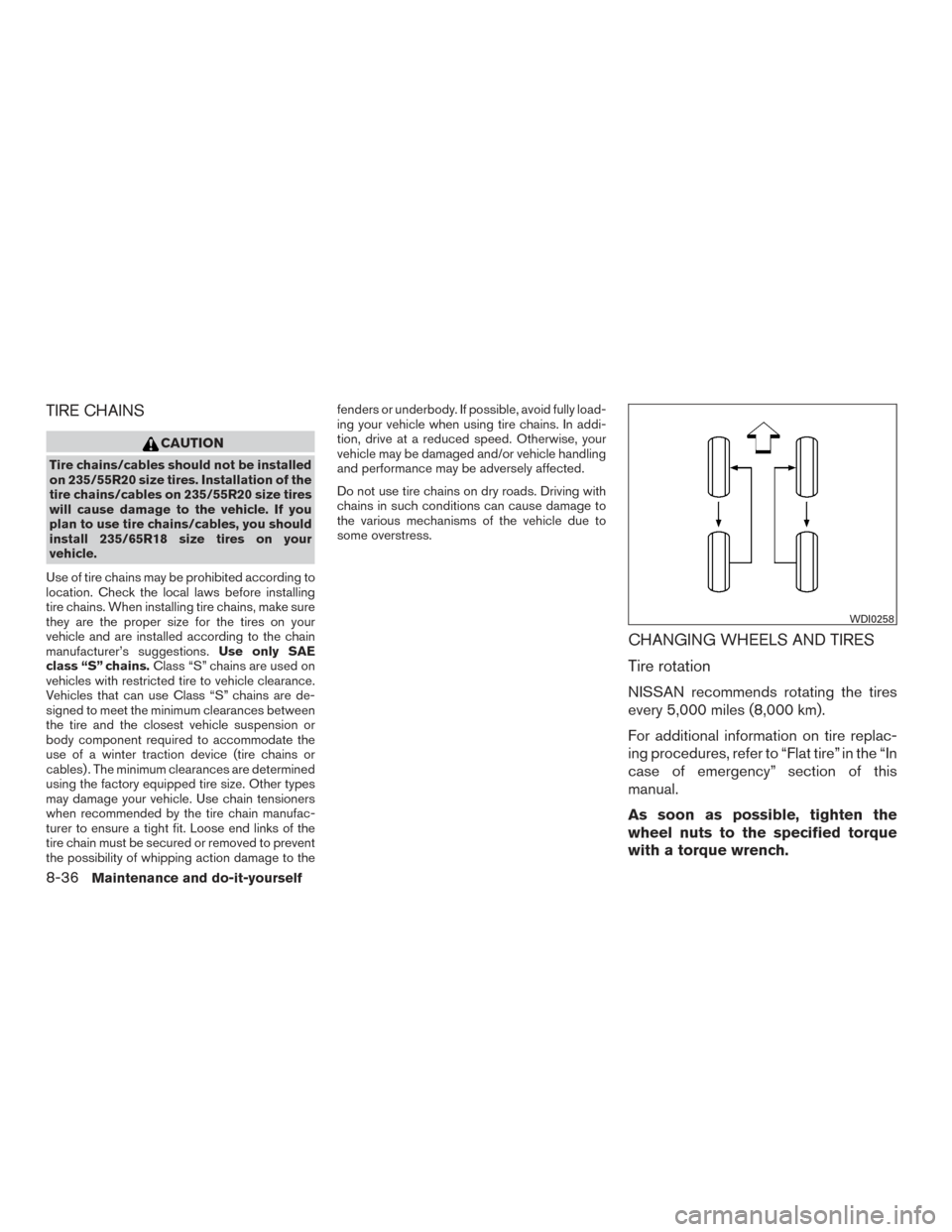
TIRE CHAINS
CAUTION
Tire chains/cables should not be installed
on 235/55R20 size tires. Installation of the
tire chains/cables on 235/55R20 size tires
will cause damage to the vehicle. If you
plan to use tire chains/cables, you should
install 235/65R18 size tires on your
vehicle.
Use of tire chains may be prohibited according to
location. Check the local laws before installing
tire chains. When installing tire chains, make sure
they are the proper size for the tires on your
vehicle and are installed according to the chain
manufacturer’s suggestions. Use only SAE
class “S” chains. Class “S” chains are used on
vehicles with restricted tire to vehicle clearance.
Vehicles that can use Class “S” chains are de-
signed to meet the minimum clearances between
the tire and the closest vehicle suspension or
body component required to accommodate the
use of a winter traction device (tire chains or
cables) . The minimum clearances are determined
using the factory equipped tire size. Other types
may damage your vehicle. Use chain tensioners
when recommended by the tire chain manufac-
turer to ensure a tight fit. Loose end links of the
tire chain must be secured or removed to prevent
the possibility of whipping action damage to the fenders or underbody. If possible, avoid fully load-
ing your vehicle when using tire chains. In addi-
tion, drive at a reduced speed. Otherwise, your
vehicle may be damaged and/or vehicle handling
and performance may be adversely affected.
Do not use tire chains on dry roads. Driving with
chains in such conditions can cause damage to
the various mechanisms of the vehicle due to
some overstress.
CHANGING WHEELS AND TIRES
Tire rotation
NISSAN recommends rotating the tires
every 5,000 miles (8,000 km).
For additional information on tire replac-
ing procedures, refer to “Flat tire” in the “In
case of emergency” section of this
manual.
As soon as possible, tighten the
wheel nuts to the specified torque
with a torque wrench.
WDI0258
8-36Maintenance and do-it-yourself
Page 483 of 540
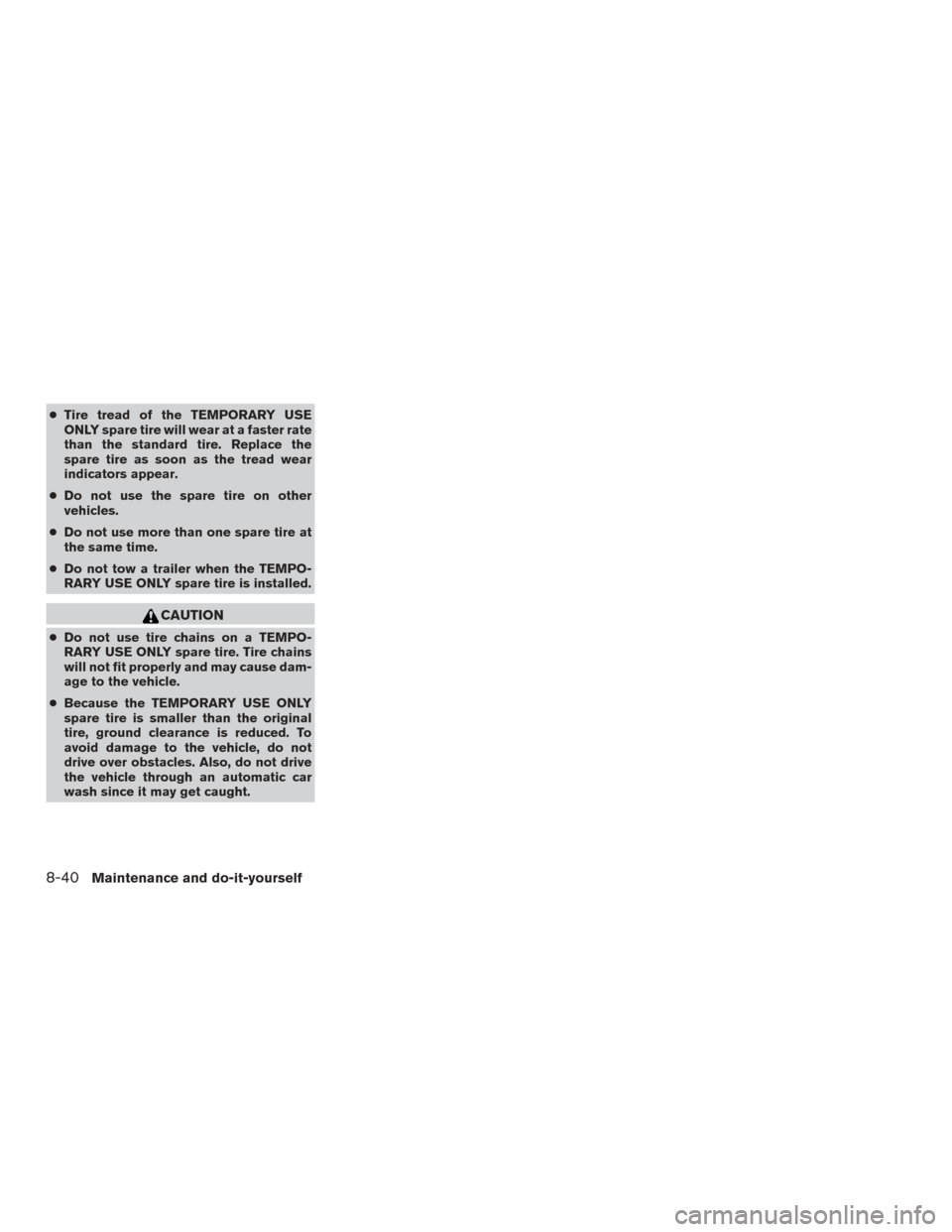
●Tire tread of the TEMPORARY USE
ONLY spare tire will wear at a faster rate
than the standard tire. Replace the
spare tire as soon as the tread wear
indicators appear.
● Do not use the spare tire on other
vehicles.
● Do not use more than one spare tire at
the same time.
● Do not tow a trailer when the TEMPO-
RARY USE ONLY spare tire is installed.
CAUTION
● Do not use tire chains on a TEMPO-
RARY USE ONLY spare tire. Tire chains
will not fit properly and may cause dam-
age to the vehicle.
● Because the TEMPORARY USE ONLY
spare tire is smaller than the original
tire, ground clearance is reduced. To
avoid damage to the vehicle, do not
drive over obstacles. Also, do not drive
the vehicle through an automatic car
wash since it may get caught.
8-40Maintenance and do-it-yourself
Page 506 of 540
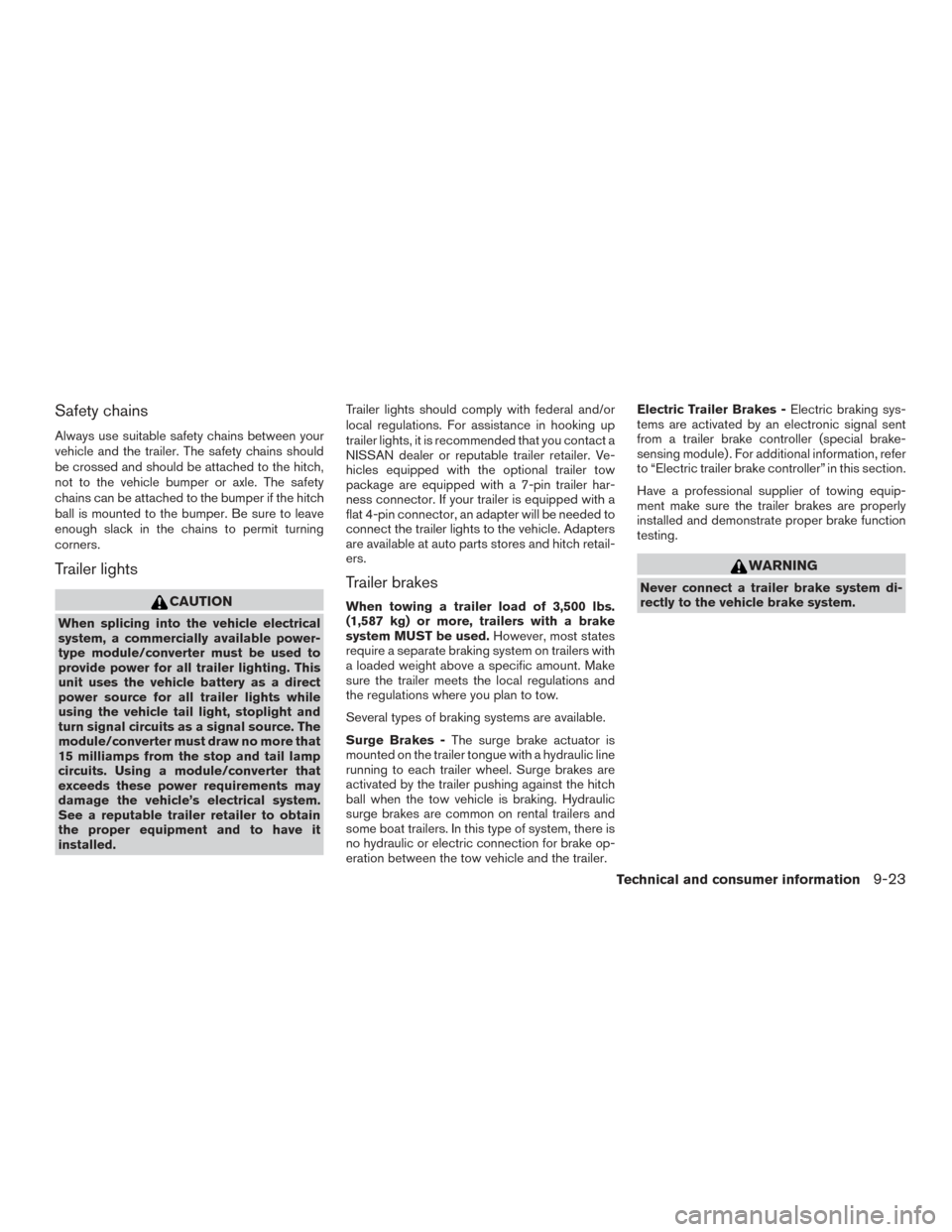
Safety chains
Always use suitable safety chains between your
vehicle and the trailer. The safety chains should
be crossed and should be attached to the hitch,
not to the vehicle bumper or axle. The safety
chains can be attached to the bumper if the hitch
ball is mounted to the bumper. Be sure to leave
enough slack in the chains to permit turning
corners.
Trailer lights
CAUTION
When splicing into the vehicle electrical
system, a commercially available power-
type module/converter must be used to
provide power for all trailer lighting. This
unit uses the vehicle battery as a direct
power source for all trailer lights while
using the vehicle tail light, stoplight and
turn signal circuits as a signal source. The
module/converter must draw no more that
15 milliamps from the stop and tail lamp
circuits. Using a module/converter that
exceeds these power requirements may
damage the vehicle’s electrical system.
See a reputable trailer retailer to obtain
the proper equipment and to have it
installed.Trailer lights should comply with federal and/or
local regulations. For assistance in hooking up
trailer lights, it is recommended that you contact a
NISSAN dealer or reputable trailer retailer. Ve-
hicles equipped with the optional trailer tow
package are equipped with a 7-pin trailer har-
ness connector. If your trailer is equipped with a
flat 4-pin connector, an adapter will be needed to
connect the trailer lights to the vehicle. Adapters
are available at auto parts stores and hitch retail-
ers.
Trailer brakes
When towing a trailer load of 3,500 lbs.
(1,587 kg) or more, trailers with a brake
system MUST be used.
However, most states
require a separate braking system on trailers with
a loaded weight above a specific amount. Make
sure the trailer meets the local regulations and
the regulations where you plan to tow.
Several types of braking systems are available.
Surge Brakes - The surge brake actuator is
mounted on the trailer tongue with a hydraulic line
running to each trailer wheel. Surge brakes are
activated by the trailer pushing against the hitch
ball when the tow vehicle is braking. Hydraulic
surge brakes are common on rental trailers and
some boat trailers. In this type of system, there is
no hydraulic or electric connection for brake op-
eration between the tow vehicle and the trailer. Electric Trailer Brakes -
Electric braking sys-
tems are activated by an electronic signal sent
from a trailer brake controller (special brake-
sensing module) . For additional information, refer
to “Electric trailer brake controller” in this section.
Have a professional supplier of towing equip-
ment make sure the trailer brakes are properly
installed and demonstrate proper brake function
testing.
WARNING
Never connect a trailer brake system di-
rectly to the vehicle brake system.
Technical and consumer information9-23
Page 521 of 540
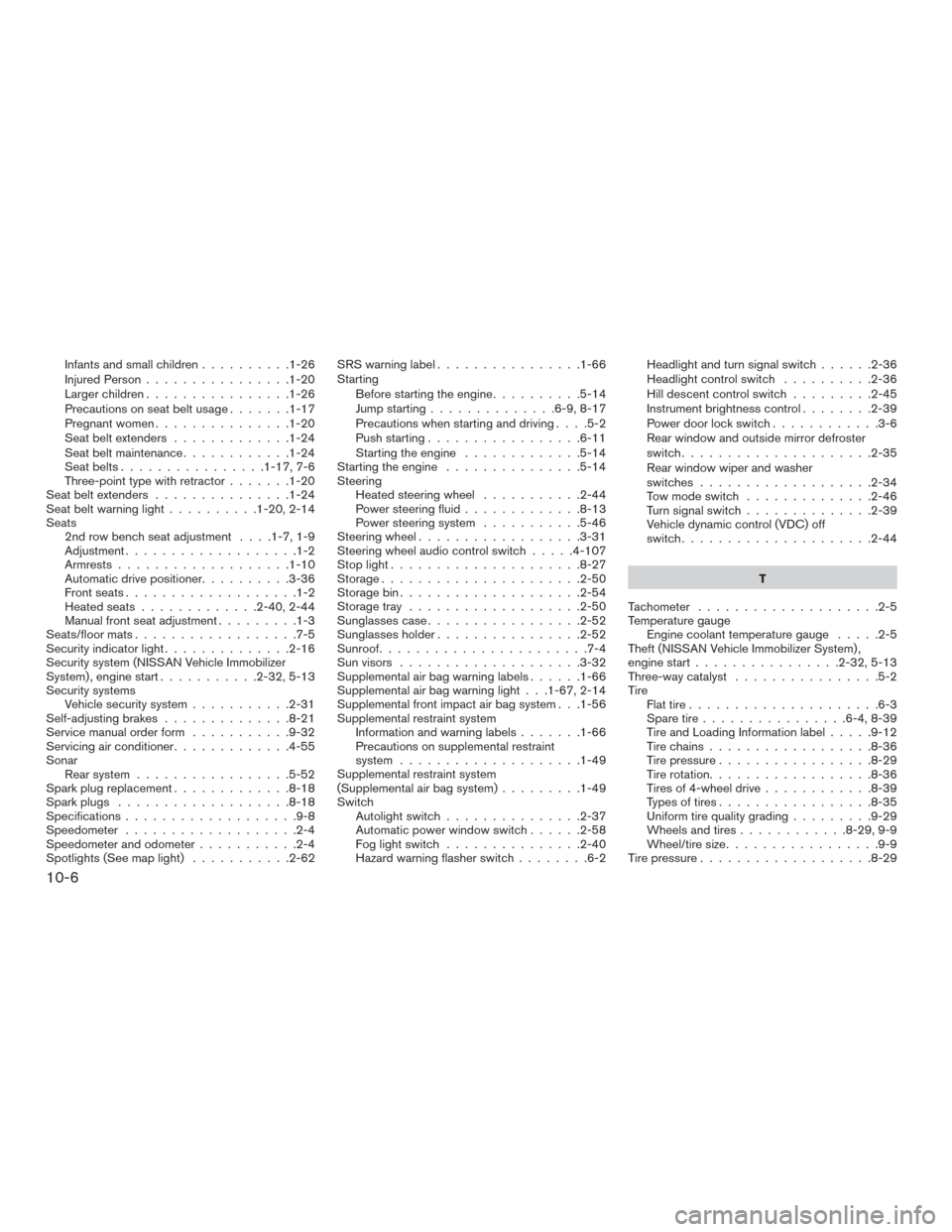
Infantsandsmallchildren..........1-26
Injured Person................1-20
Largerchildren................1-26
Precautionsonseatbeltusage.......1-17
Pregnant women ...............1-20
Seat belt extenders .............1-24
Seat belt maintenance ............1-24
Seat belts ................1-17,7-6
Three-point type with retractor .......1-20
Seat belt extenders ...............1-24
Seatbeltwarninglight..........1-20,2-14
Seats 2nd row bench seat adjustment ....1-7,1-9
Adjustment ...................1-2
Armrests...................1-10
Automatic drive positioner ..........3-36
Frontseats...................1-2
Heatedseats.............2-40,2-44
Manual front seat adjustment .........1-3
Seats/floor mats ..................7-5
Security indicator light ..............2-16
Security system (NISSAN Vehicle Immobilizer
System) , engine start ...........2-32,5-13
Security systems Vehicle security system ...........2-31
Self-adjusting brakes ..............8-21
Service manual order form ...........9-32
Servicing air conditioner .............4-55
Sonar Rear system .................5-52
Spark plug replacement .............8-18
Spark plugs ...................8-18
Specifications ...................9-8
Speedometer ...................2-4
Speedometer and odometer ...........2-4
Spotlights(Seemaplight) ...........2-62 SRSwarninglabel................1-66
Starting
Before starting the engine ..........5-14
Jump starting ..............6-9,8-17
Precautions when starting and driving ....5-2
Push starting .................6-11
Starting the engine .............5-14
Starting the engine ...............5-14
Steering Heated steering wheel ...........2-44
Power steering fluid .............8-13
Power steering system ...........5-46
Steeringwheel..................3-31
Steering wheel audio control switch .....4-107
Stoplight.....................8-27
Storage......................2-50
Storagebin....................2-54
Storage tray ...................2-50
Sunglassescase.................2-52
Sunglassesholder................2-52
Sunroof.......................7-4
Sun visors ....................3-32
Supplemental air bag warning labels ......1-66
Supplemental air bag warning light . . .1-67, 2-14
Supplemental front impact air bag system . . .1-56
Supplemental restraint system Information and warning labels .......1-66
Precautions on supplemental restraint
system ....................1-49
Supplemental restraint system
(Supplemental air bag system) .........1-49
Switch Autolightswitch...............2-37
Automatic power window switch ......2-58
Foglightswitch ...............2-40
Hazard warning flasher switch ........6-2Headlightandturnsignalswitch......2-36
Headlight control switch
..........2-36
Hilldescentcontrolswitch.........2-45
Instrument brightness control ........2-39
Power door lock switch ............3-6
Rear window and outside mirror defroster
switch .....................
2-35
Rear window wiper and washer
switches ...................2-34
Tow mode switch ..............2-46
Turnsignalswitch..............2-39
Vehicle dynamic control (VDC) off
switch .....................2-44
T
Tachometer ....................2-5
Temperature gauge Engine coolant temperature gauge .....2-5
Theft (NISSAN Vehicle Immobilizer System) ,
engine start ................2-32,5-13
Three-way catalyst ................5-2
Tire Flat tire .....................6-3
Spare tire ................6-4,8-39
Tire and Loading Information label .....9-12
Tire chains ..................8-36
Tire pressure .................8-29
Tire rotation..................8-36
Tires of 4-wheel drive ............8-39
Types of tires .................8-35
Uniform tire quality grading .........9-29
Wheels and tires ............8-29,9-9
Wheel/tire size .................9-9
Tirepressure...................8-29
10-6